MUSSEL-MANIA
 Friday was our last at the Salad Station (Garde Manger) before we moved on to the new summer menu, new recipe books, our own concoctions and our next stop: the Vegetarian station, Entremetier. The mussel dish didn't look that complicated-- I was more focused on the test on Chapters One through Nine from our Level One books. I hadn't looked through it since moving on to Level Two and spent much of the day reviewing flashcards and thinking about how I should re-write all the Level One Recipes in a little black book that I can carry in a pocket so that I'll always have quick access to all the basics.
Friday was our last at the Salad Station (Garde Manger) before we moved on to the new summer menu, new recipe books, our own concoctions and our next stop: the Vegetarian station, Entremetier. The mussel dish didn't look that complicated-- I was more focused on the test on Chapters One through Nine from our Level One books. I hadn't looked through it since moving on to Level Two and spent much of the day reviewing flashcards and thinking about how I should re-write all the Level One Recipes in a little black book that I can carry in a pocket so that I'll always have quick access to all the basics.DISH: Steamed Mussels with White Wine, Shallots, and Parsley (Bretagne), Moules À La Marinière
RECIPE: The following recipe is for 8 servings. Scrub 2,400G mussels and soak in heavily salted water for 20 minutes. Discard any mussels that do not open. Drain and rinse remaining good mussels.
Pick off nice parsley tips for garnish then stem the rest of one small bunch and set aside separately stems and leaves separately-- chop both. Cut 200G butter into small diced cubes. Finely dice (ciselee) 80G shallots and reserve.
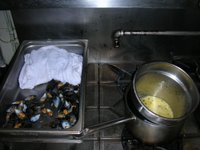 In a wide sautoir put 250 to 300G mussels, a pinch of chopped parsley stems, a few pieces of butter, one tablespoon minced shallots, about 60ml white wine a bay leaf and a few turns from the peppermill. Cover and bring to boil, shaking regularly. As mussels open, remove to a metal bowl. Remove beards (right, the mussels kept warm under a damp towel on the stove for service and the broth in a bain-marie). Repeat process until all mussels are cooked (using about 500 ml white wine and two bay leaves).
In a wide sautoir put 250 to 300G mussels, a pinch of chopped parsley stems, a few pieces of butter, one tablespoon minced shallots, about 60ml white wine a bay leaf and a few turns from the peppermill. Cover and bring to boil, shaking regularly. As mussels open, remove to a metal bowl. Remove beards (right, the mussels kept warm under a damp towel on the stove for service and the broth in a bain-marie). Repeat process until all mussels are cooked (using about 500 ml white wine and two bay leaves).Decant broth and strain, boil and reduce. Mount with a tablespoon of butter (monter au beurre) and check seasoning.
Remove top half of the shells and arrange in a wide shallow bowl. Reheat briefly in the oven. Spoon broth over mussels, sprinkle chopped parsley and serve right away.
 BREAKDOWN: The test wasn't terribly difficult, ten questions like: what types of bones are used in a marmite? what are the mother sauces? name five stocks? We have another test on Wednesday, this one on the recipes we are to be making on our individual stations. I forgot to ask which one we're supposed to study as we'll be making up our own dishes next Wednesday.
BREAKDOWN: The test wasn't terribly difficult, ten questions like: what types of bones are used in a marmite? what are the mother sauces? name five stocks? We have another test on Wednesday, this one on the recipes we are to be making on our individual stations. I forgot to ask which one we're supposed to study as we'll be making up our own dishes next Wednesday.For restaurant service we mulitplied all ingredients above by three. The salt-soaking at the beginning is meant to trick the mussels into acting as though they are in actual seawater where they would open up. By opening, there's more of a chance that the mussels will purge any of the grit still inside.
The biggest difference between the recipe in the book and what we actually did was to strain the broth repeatedly through a cheesecloth to ensure that there wasn't going to be any grit winding up on the plates that were going out into the restaurant. We strained it about four or five times through the cheesecloth placed in a fine chinois (china cap). We also placed a sprig of parsley in the middle of the mussels which we served six to a plate.
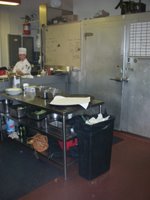 A few things to wrap up the night, which was very smooth to the point of being a little boring. To the right is our service station with the tray on it where we place the plates before they are brought out to the customers (or "guests"). Under the service station you can see some of our belongings, toolboxes, supples, etc., and behind it is the walk-in refridgerator.
A few things to wrap up the night, which was very smooth to the point of being a little boring. To the right is our service station with the tray on it where we place the plates before they are brought out to the customers (or "guests"). Under the service station you can see some of our belongings, toolboxes, supples, etc., and behind it is the walk-in refridgerator.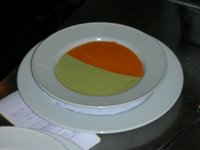 The Level Four students made a soup (left) that was half tomato and half asparagus that was served with asparagus sprigs and chopped tomatoes. With all the time we had we also made a soup, one suggested by Chef W., a carrot-ginger soup.
The Level Four students made a soup (left) that was half tomato and half asparagus that was served with asparagus sprigs and chopped tomatoes. With all the time we had we also made a soup, one suggested by Chef W., a carrot-ginger soup.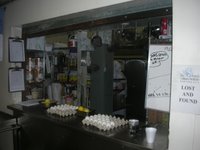 In order to get the ingredients for the soup (which we were making for ourselves, for practice, it wouldn't be served in the restaurant) we went to the storeroom, left. You can see flats of eggs on the shelf to be put away, leftovers from pastry.
In order to get the ingredients for the soup (which we were making for ourselves, for practice, it wouldn't be served in the restaurant) we went to the storeroom, left. You can see flats of eggs on the shelf to be put away, leftovers from pastry.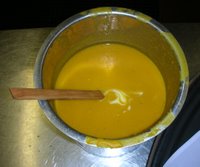 Our carrot-ginger soup consisted of five carrots, one two-inch piece of ginger, five cups of white chicken stock, one medium onion, one tablespoon each of tumeric, coriander, fresh dill sprigs, two bay leaves, and black peppercorn. We gave the onion and the peeled and sliced carrots some color on heat in butter, added the chicken stock, the tumeric and a sachet full of the peppercorns, bay leaf, coriander and dill sprigs. We brought it to a boil then pureed it in a blender with the peeled and chopped ginger.
Our carrot-ginger soup consisted of five carrots, one two-inch piece of ginger, five cups of white chicken stock, one medium onion, one tablespoon each of tumeric, coriander, fresh dill sprigs, two bay leaves, and black peppercorn. We gave the onion and the peeled and sliced carrots some color on heat in butter, added the chicken stock, the tumeric and a sachet full of the peppercorns, bay leaf, coriander and dill sprigs. We brought it to a boil then pureed it in a blender with the peeled and chopped ginger.Unfortunately, it turned out to be more of a ginger-carrot soup than a carrot-ginger soup. We balanced it out some with coconut milk and honey but the ginger was overpowering. I'd certainly use less if I were making the soup again. It might have been a better soup cold but as it was nobody was interested in taking any home and it ended up as basura (garbage).





0 Comments:
Post a Comment
<< Home